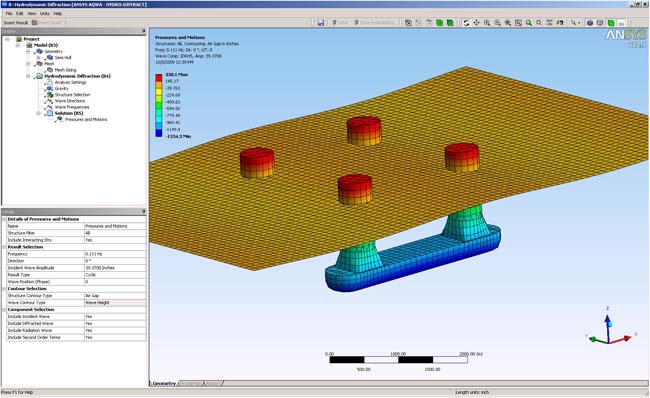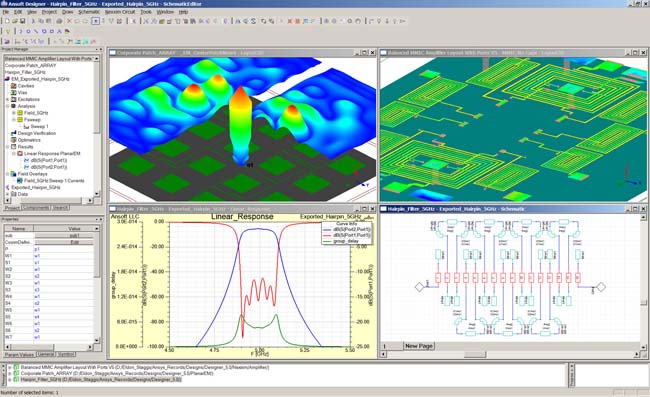December 9, 2009
By DE Editors
ANSYS, Inc., has announced the availability of ANSYS 12.1, which incorporates tools that further automate the product development process. The company has also released Ansoft Designer 5.0 and Nexim 5.0, which include new features that compress the electronic design and analysis cycle.
 ANSYS 12.1 integrates the ANSYS AQWA product within the ANSYS Workbench framework, offering extended automation and process compression to engineers who must predict hydrodynamics loads caused by waves that impact offshore structures and marine vessels. ANSYS AQWA users can now benefit from direct linkage to ANSYS DesignModeler for importing external CAD geometry. The integration facilitates the use of geometric parameterization. Image courtesy of ANSYS, Inc. |
ANSYS 12.1 extends the integration of its products with several industry applications—for electronics, polymer and glass-forming, and hydrodynamic applications—into the ANSYS Workbench environment, resulting in faster modeling times and cross-physics integration. New to release 12.1 are tools that extend the already existing capability of real-world simulation authoring in the ANSYS Workbench platform, introducing the ability to record, customize, and automate analysis steps through journaling and scripting. Journaling captures operations that modify data in an ANSYS Workbench simulation session and records them in a journal file. A journal file can be replayed to return the state of a resumed ANSYS Workbench session. Alternatively, a journal can be modified to change or incorporate additional operations, which are referred to as scripting. ANSYS Workbench journaling and scripting allow users to replay previously recorded journals or to reconstruct previously created projects, automate repetitive tasks or execute simulation projects in batch mode. The new automation and customization solution now links all ANSYS Workbench integrated solver and modeling technologies.
For release 12.1, ANSYS integrates three of its industry-specific applications within the ANSYS Workbench framework — for electronics, polymer and glass-forming, and hydrodynamic analyses. This integration extends automation and process compression of the platform’s geometry, meshing, parameters, and post-processing solution to these industry segments. With ANSYS Icepak, which is used for rapid creation of complex electronic assembly models, this integration results in MCAD connectivity and the ability to create multiphysics thermal–stress solutions using ANSYS Mechanical software. In polymer processing and glass-forming applications, the integration of ANSYS POLYFLOW software gives die engineers the ability to predict stresses that occur during cool-down following high-temperature production processes. ANSYS AQWA users—who study loads caused by waves on offshore structures and marine vessels—can benefit from the direct linkage to ANSYS DesignModeler through importing of external CAD geometry and using geometric parameterization.
Another framework enhancement at release 12.1 is the External Connection add-in, which allows applications that are not yet integrated with ANSYS Workbench to communicate with the framework by sharing parameters in the workflow. The add-in allows external applications to take advantage of the automation that ANSYS 12.1 provides. The External Connection triggers access to other ANSYS Workbench functionality, including design of experiments, sensitivity and six sigma design studies.
Ansoft Designer with NEXXIM 5.0
ANSYS, Inc. has also announced its Ansoft Designer 5.0 and Nexxim 5.0 products. This engineering simulation platform and integrated technology supports simulation driven product development of electronic products.
 The DesignerRF PlanarEM package includes 3-D planar electromagnetics with linear circuit simulation capabilities. Image courtesy of ANSYS, Inc. |
For example, links with ANSYS DesignXplorer software enable design of experiments, sensitivity studies, and six-sigma design. Additionally, a distributed-solve high-performance computing (HPC) capability has been added that allows engineers to analyze process variations within a full signal integrity (SI) analysis across a network of computers. For radio frequency (RF) and microwave design, Ansoft Designer 5.0 with Nexxim 5.0 feature a new system simulation engine that allows engineers to simulate entire wireless systems while linking to transistor and electromagnetic models.
The Ansoft Designer 5.0 and Nexxim 5.0 suite also offers new product packaging that customizes and streamlines Ansoft Designer and Nexxim simulation technology into application-specific software tools for engineers focused on signal integrity analysis or RF and microwave design. The new packages, named DesignerSI and DesignerRF, integrate technology from Ansoft Designer and Nexxim into application-specific engineering platforms that are easy to use and straightforward to acquire.
The DesignerSI package includes the Ansoft Designer integrated schematic capture and layout graphical user interface (GUI), 2-D quasi-static field solver and the Nexxim circuit simulation technology (transient, fast convolution, statistical, and IBIS-AMI). DesignerRF includes the Ansoft Designer desktop, 3-D planar electromagnetic field solver, RF system simulation tool, design synthesis tools, circuit simulation, powered by Nexxim (linear and nonlinear frequency domain). Both packages include a design management front end for the Ansoft electromagnetic field simulation technologies HFSS, Q3D Extractor and SIwave software.
The DesignerSI product suite will suit engineers designing high-speed electronic interfaces including XAUI, XFI, Serial ATA, PCI Express, HDMI, DDR, DDR2, and DDR3. Engineers using DesignerSI can leverage its optimization algorithms, design of experiments, tuning and post-processing capabilities for signal-integrity metrics, such as time-domain reflectometry (TDR), bit-error-rate (BER), timing analysis, and eye diagrams. All SI analyses can dynamically link to electromagnetic extraction.
For more information, visit ANSYS, Inc.
Sources: Press materials received from the company and additional information gleaned from the company’s website.
Subscribe to our FREE magazine, FREE email newsletters or both!
About the Author
DE’s editors contribute news and new product announcements to Digital Engineering.
Press releases may be sent to them via [email protected].






